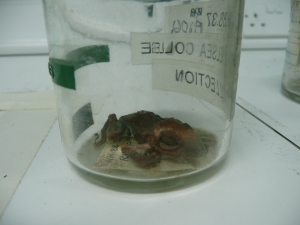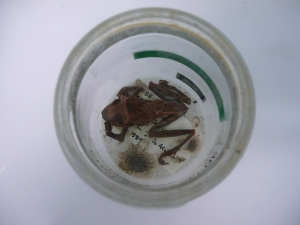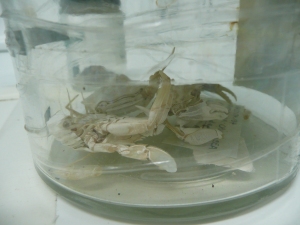So, this week I am attending an excellent course in fluid preservation of natural history specimens run by Simon Moore. Handily, it is also being held at the Horniman this time round, so I don’t even have to go out of my way!
Day one featured a morning of lectures on the various problems that face fluid preserved specimens, including drying out, lipid contamination, and incomplete fixation. There was a lot of information to take in, and a lot of chemistry involved – I haven’t studied organic chemistry since university so I’m a bit rusty, and I can’t say I took in all of the details of fixative formulae and chemical reactions! But the theory was followed by practical, which always makes things clearer.
The practical side of the course involves rehydrating some completely dried out specimens. The first step was to choose specimens – I managed to bag myself a small, rather mouldy tree frog (of the genus Rhacophorus), and a jar of three crabs (labelled as Portunus depurator, now called Liocarcinus depurator, the harbour crab).
The first step in rehydration is to bathe the specimens in a dilute solution of Decon-90 (which is usually used as a surface-active cleaning agent and radioactive decontaminant, but is also excellent for rehydrating dried tissues). I decanted the specimens from their jars into beakers, and placed them on hotplates to warm the Decon-90 solution slightly, which catalyses the reaction.
And in their baths they will stay overnight, as my specimens remain quite stiff and unreponsive so far. Tomorrow they will be treated in a mild vacuum to remove the air pockets that are causing them to float at the moment.
While waiting impatiently for our specimens to show signs of improvement, Simon showed us some techniques for glass cutting, which is important for making new lids for specimen jars, and also showed us how to drill holes in jars to top up fluids without having to remove the lid (which is often quite a chore if the jar has been well sealed).
By the end of the week I hope my little critters will look plump, healthy and lifelike again! I will keep you updated on progress…







